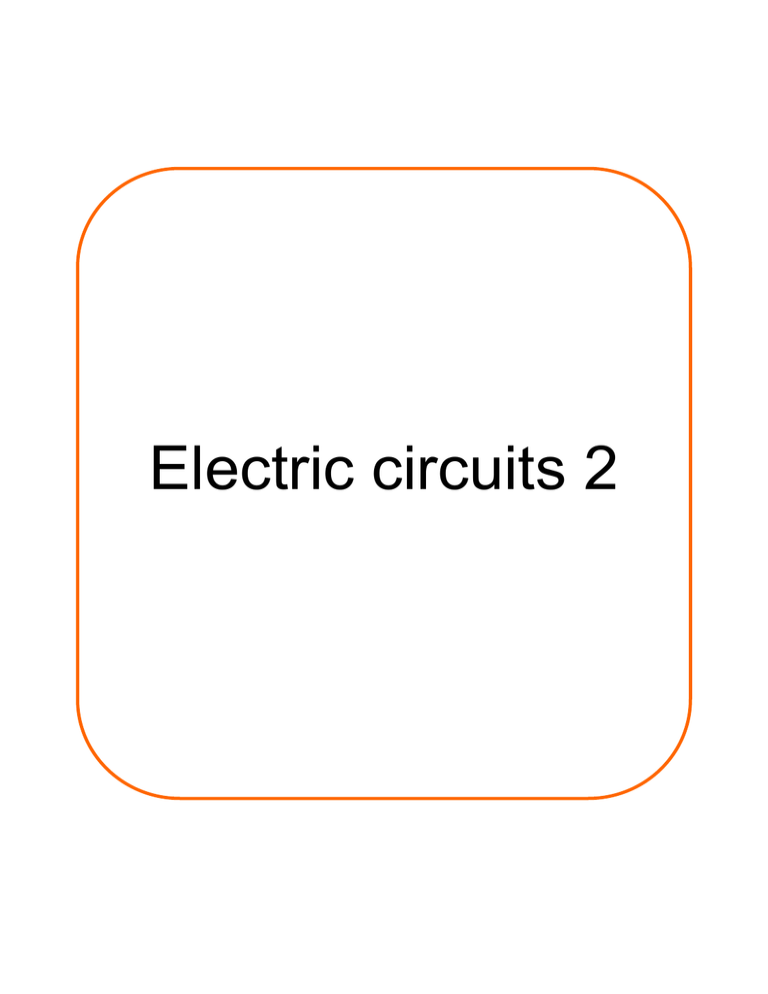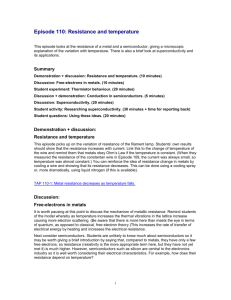P2.6_-_Electric_circuits_2_answers 380KB Jun 06 2014 10:44
advertisement

Electric circuits 2 1) Which of the above graphs represents a diode? …………B……………………..(1 mark) 2) Which of the above graphs represents a lamp? ………………D………………………………………..(1 mark) 3) Which of the above graphs represents a wire? …………………C……………………………………..(1 mark) 4) Using the line of best fit, what current was flowing through the lamp when the potential difference was 2V? …………………0.2A…………………..(1 mark) 5) What was the resistance of the lamp at this time? ……………………2 V / 0.2 A = 10 Ohms………………..(2 marks) 6)For the positive section of the above graph, explain why it shows these characteristics. The filament lamp heats up (1mark) As the temperature increases the resistance increases (1 mark) As the resistance increases the amount of current that can flow decreases (1 mark) (3 marks) A B C D 7) The mains supply in the UK is rated at 230V and 50Hz. i) What are the values of A and B? …………………………+230V and -230V ……(1 mark) ii) What is the time difference between C and D? ……………………1/50 second…………………….(1 mark) iii) Describe what the graph would look like if the frequency was increased to double its normal value. ………… There would be twice as many period in the same time (1 mark) The Amplitude would remain the same (1 mark) …………….………………………………………………………. (3 marks) A G F B C E D 8) i)For the above plug, give the correct letter for each part. The live wire The earth wire The fuse The cable grip The neutral pin G A F E C (5 marks) ii) What material is used for the following parts and why? The pins. Brass – good electrical conductor, strong, cheap(2 marks) The cable grip. Plastic – strong, electrical insulator ..(2 marks) 9) a) i) What is the equation that links potential difference, power and current? …………power = potential difference x current / P=VI (1 mark) ii) If a 60W lamp has a current of 0.25Amps flowing through it what is the potential difference across the lamp? …….......... V = P/I = 60/0.25 = 230 V ..........................(2 marks) iii) If a 100W lamp has a potential difference of 230V across it, what current is flowing through the lamp? ………............ I=P/V 100/230 = 0.43A .........................(2 marks) b) A heater has a rating of 500W and 230V. i) Calculate the current through the heater. I = P/V = 500/230 = 2.17A …………...(2 marks) i) Which fuse would be the best option to use? (Circle the correct answer.) 3A, 5A or 13A (1 mark) The graph shows how the current through a filament lamp changes as the voltage (potential difference) across it changes. Explain why the graph is not a straight line. To gain full marks in this question you should write your ideas in good English. Put them into a sensible order and use the correct scientific words. QoWC for the use of the word resistance accept increase / change / decrease throughout question but a contradiction loses one mark as the pd / current increases / changes the temperature of the filament increases / changes increasing / changing the resistance of the lamp accept for 1 mark only the filament lamp does not obey Ohm.s law (4 marks) The diagram shows water waves made by a wave machine in a swimming pool. In 10 seconds 5 complete waves go past a person standing in the pool. Calculate the frequency of the water waves and give the unit. Show how you work out your answer. .................................5/10 = 0.5...................................................... Frequency = 0.5 Hertz .... (2 marks) (b) Water waves are transverse waves. Give one other example of a transverse wave. ..... any named part of the electromagnetic spectrum • S . waves / secondary waves • wave on a rope............(1 mark) (c) How is a transverse wave different from a longitudinal wave? You may draw a diagram to help you with your answer. transverse - disturbance / vibration is perpendicular to the direction of energy transfer / wave travel longitudinal - disturbance / vibration is parallel to the direction of energy transfer / wave travel(2 marks)







